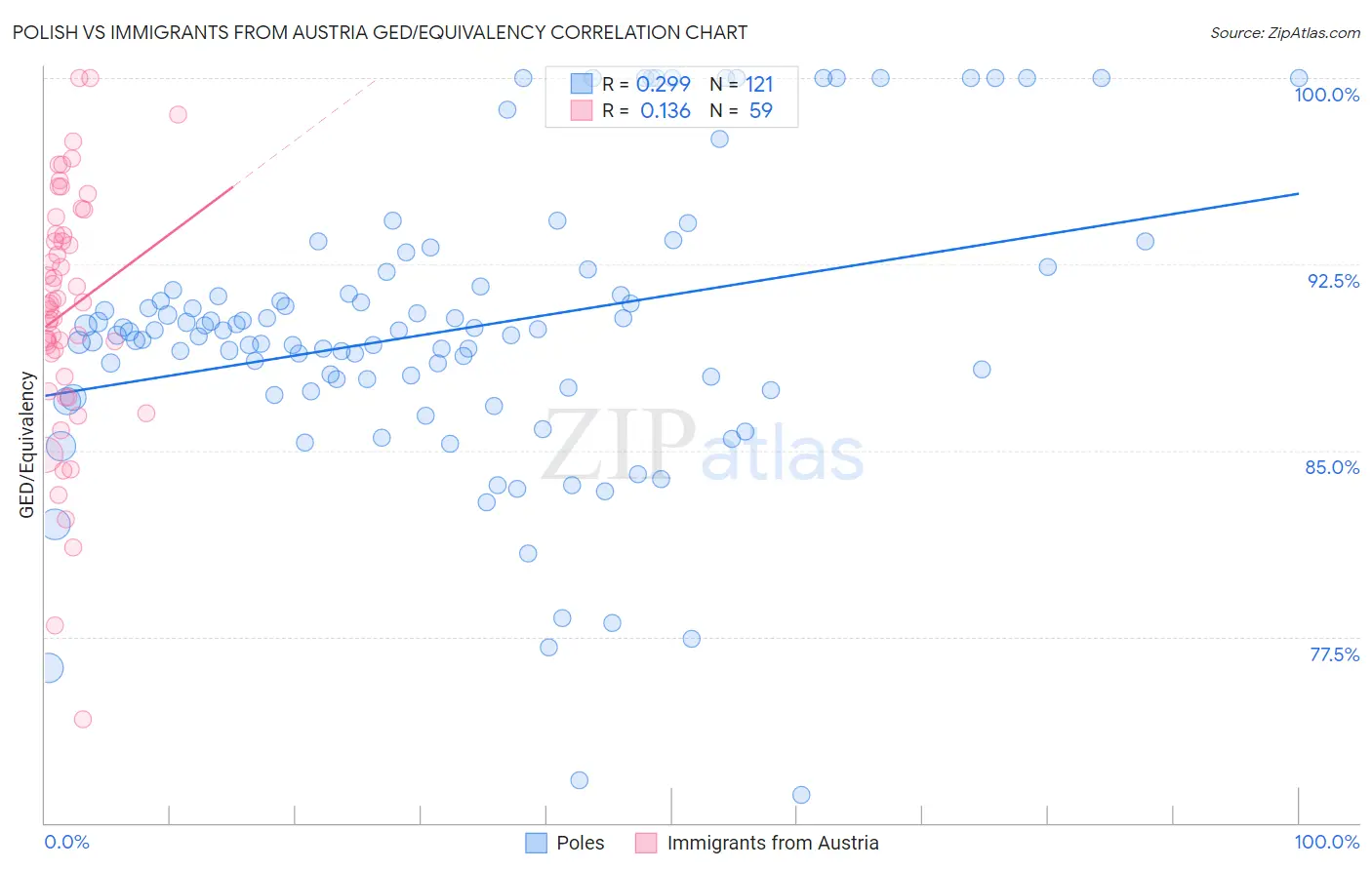Polish vs Immigrants from Austria GED/Equivalency
COMPARE
Polish
Immigrants from Austria
GED/Equivalency
GED/Equivalency Comparison
Poles
Immigrants from Austria
88.5%
GED/EQUIVALENCY
99.8/ 100
METRIC RATING
29th/ 347
METRIC RANK
88.3%
GED/EQUIVALENCY
99.7/ 100
METRIC RATING
37th/ 347
METRIC RANK
Polish vs Immigrants from Austria GED/Equivalency Correlation Chart
The statistical analysis conducted on geographies consisting of 560,593,858 people shows a weak positive correlation between the proportion of Poles and percentage of population with at least ged/equivalency education in the United States with a correlation coefficient (R) of 0.299 and weighted average of 88.5%. Similarly, the statistical analysis conducted on geographies consisting of 167,973,751 people shows a poor positive correlation between the proportion of Immigrants from Austria and percentage of population with at least ged/equivalency education in the United States with a correlation coefficient (R) of 0.136 and weighted average of 88.3%, a difference of 0.19%.

GED/Equivalency Correlation Summary
| Measurement | Polish | Immigrants from Austria |
| Minimum | 71.1% | 74.2% |
| Maximum | 100.0% | 100.0% |
| Range | 28.9% | 25.8% |
| Mean | 89.8% | 90.6% |
| Median | 89.8% | 90.9% |
| Interquartile 25% (IQ1) | 87.5% | 88.0% |
| Interquartile 75% (IQ3) | 91.5% | 93.7% |
| Interquartile Range (IQR) | 4.1% | 5.7% |
| Standard Deviation (Sample) | 5.8% | 5.0% |
| Standard Deviation (Population) | 5.8% | 5.0% |
Demographics Similar to Poles and Immigrants from Austria by GED/Equivalency
In terms of ged/equivalency, the demographic groups most similar to Poles are Turkish (88.5%, a difference of 0.020%), Immigrants from Northern Europe (88.5%, a difference of 0.030%), Bhutanese (88.4%, a difference of 0.050%), Immigrants from Lithuania (88.6%, a difference of 0.070%), and Danish (88.4%, a difference of 0.070%). Similarly, the demographic groups most similar to Immigrants from Austria are Immigrants from Belgium (88.3%, a difference of 0.030%), Burmese (88.3%, a difference of 0.030%), Immigrants from South Central Asia (88.4%, a difference of 0.050%), Immigrants from Japan (88.4%, a difference of 0.070%), and Immigrants from Sweden (88.4%, a difference of 0.080%).
| Demographics | Rating | Rank | GED/Equivalency |
| Russians | 99.8 /100 | #23 | Exceptional 88.6% |
| Slovaks | 99.8 /100 | #24 | Exceptional 88.6% |
| Estonians | 99.8 /100 | #25 | Exceptional 88.6% |
| Immigrants | Australia | 99.8 /100 | #26 | Exceptional 88.6% |
| Immigrants | Lithuania | 99.8 /100 | #27 | Exceptional 88.6% |
| Immigrants | Northern Europe | 99.8 /100 | #28 | Exceptional 88.5% |
| Poles | 99.8 /100 | #29 | Exceptional 88.5% |
| Turks | 99.8 /100 | #30 | Exceptional 88.5% |
| Bhutanese | 99.8 /100 | #31 | Exceptional 88.4% |
| Danes | 99.8 /100 | #32 | Exceptional 88.4% |
| Immigrants | Sweden | 99.7 /100 | #33 | Exceptional 88.4% |
| Immigrants | Japan | 99.7 /100 | #34 | Exceptional 88.4% |
| Immigrants | South Central Asia | 99.7 /100 | #35 | Exceptional 88.4% |
| Immigrants | Belgium | 99.7 /100 | #36 | Exceptional 88.3% |
| Immigrants | Austria | 99.7 /100 | #37 | Exceptional 88.3% |
| Burmese | 99.7 /100 | #38 | Exceptional 88.3% |
| Immigrants | Israel | 99.6 /100 | #39 | Exceptional 88.2% |
| Italians | 99.6 /100 | #40 | Exceptional 88.2% |
| Finns | 99.6 /100 | #41 | Exceptional 88.2% |
| Cambodians | 99.6 /100 | #42 | Exceptional 88.2% |
| Immigrants | Scotland | 99.6 /100 | #43 | Exceptional 88.2% |